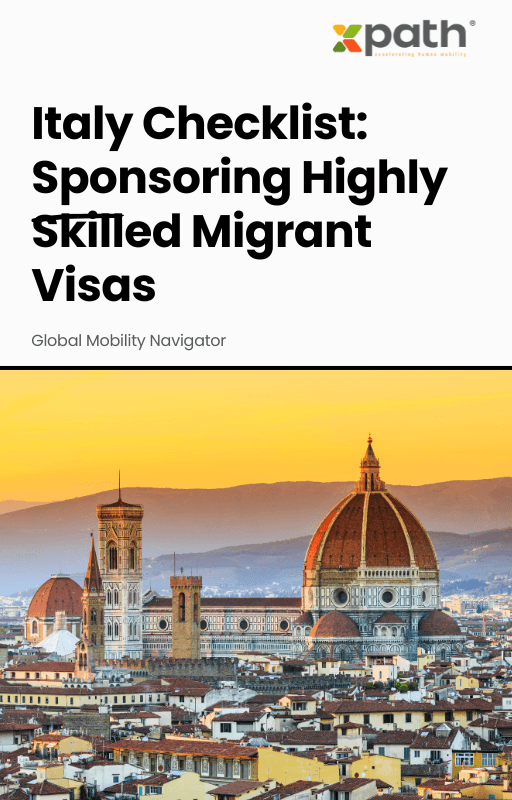Italy Checklist: Sponsoring Highly Skilled Migrant Visas
Grab a copy of a guide to international employee relocation
View E-bookCast your mind back a decade. Global mobility—getting the right people to the right places, legally and efficiently—meant reams of paperwork, endless vendor calls, and eye-watering bills for HR tech. Fast forward to today: globalization and remote work have hopped in the driver’s seat, pushing companies to rethink their game plan. According to a recent Deloitte survey, nearly 85% of organizations rank employee mobility as a critical business priority, yet 63% still see cost as the number one challenge. But the numbers dance a new rhythm: cloud solutions, SaaS models, and global networks are slashing costs by double-digit percentages each year. Suddenly, “best-in-class mobility tech” doesn’t sound so expensive, does it?
Tech prices don’t just fall randomly—the shift is driven by innovation and volume. A 2023 PwC report found that companies using cloud-based mobility solutions saw total costs decrease by up to 40% compared to legacy systems. That’s not pocket change. Not only do cloud platforms ditch expensive hardware investments, but they also cut support and upgrade costs to a fraction of the old price. Plus, with the ability to pay per user or per move, SMBs and global giants alike get scalability without the sticker shock. Mobility tech is finally stepping out of its luxury-only shadow and becoming the practical, affordable backbone for global talent.
Let’s turn stats into stories. Picture a fast-growth software company, scaling internationally with a tight budget. By switching from an on-premise legacy system to a modern global mobility platform, they slashed their operational costs by 35% in just one year. How? Automation killed manual data entry; integrated compliance cut expensive outsourcing; and in-house teams, powered by smart dashboards, responded to relocations twice as fast. Add to that a system like xpath.global—which brings services, compliance, and partner management into one digital space—and you’ve got a blueprint for doing more with less.
Let’s unpack the trends. First, cloud adoption is exploding: Gartner forecasts that by 2026, over 75% of multinational organizations will rely on cloud-based platforms for mobility management. Competition among tech vendors is fierce, which means more features for less cash. And the rise of “mobility as a service” (MaaS) means that even complex compliance or tax services can be accessed on-demand with transparent, predictable costs. Platforms like xpath.global enable you to get near-real-time quotes and service comparisons, so surprises are a thing of the past. The bottom line? Cost is shrinking, value is rising.
Sure, cheaper is great, but don’t fall for the bargain-bin trap. The real challenge is understanding what’s worth the spend. Spotting compliant, scalable, and easy-to-integrate solutions—like those from xpath.global—matters more than just hunting for a low monthly rate. Think of it as upgrading from an old flip phone to a smartphone: the sticker price might be close, but what you get in return—automation, visibility, risk reduction—pays for itself many times over. Focus on solutions that centralize data, support flexible policies, and connect you to trusted global partners. The right investment can turn mobility from a cost center to a value creator in no time.
Here’s the truth few talk about: when companies deploy agile, data-driven mobility tech, the real wins go far beyond cost-cutting. Happy relocated employees? Check. Faster deployment and project success? Double check. Simpler compliance with changing laws and tax rules? You bet. And with smart vendor marketplaces like xpath.global, you future-proof your operations while keeping budgets in check. It’s not just about spending less—it’s about unleashing growth.
Q: Isn’t a comprehensive mobility solution still a big upfront investment?
Nope—modern solutions like xpath.global run on a SaaS or marketplace model. You pay for what you use, with minimal setup costs and no massive upfront fees.
Q: What about hidden costs with cloud mobility platforms?
Transparency has improved! With platforms like xpath.global, service prices are clear, contracts are streamlined, and you can compare providers before you commit.
Q: How can smaller companies afford enterprise-level mobility systems?
By choosing platforms built for scalability. Many providers let you start small and grow as your program expands—no need to over-buy in advance.
Q: Is automation just a buzzword, or does it really cut costs?
It’s the real deal. Automation reduces manual tasks, speeds up compliance, and minimizes human error, all of which directly lowers your spending.
Q: What should I look for in a modern mobility solution to control costs?
Centralized data, user-friendly dashboards, compliance checks, and a marketplace for comparing vendors—features that deliver value beyond the price tag.
Ready to transform your mobility program? Explore xpath.global’s solutions.

Italy Checklist: Sponsoring Highly Skilled Migrant Visas
Grab a copy of a guide to international employee relocation
View E-book